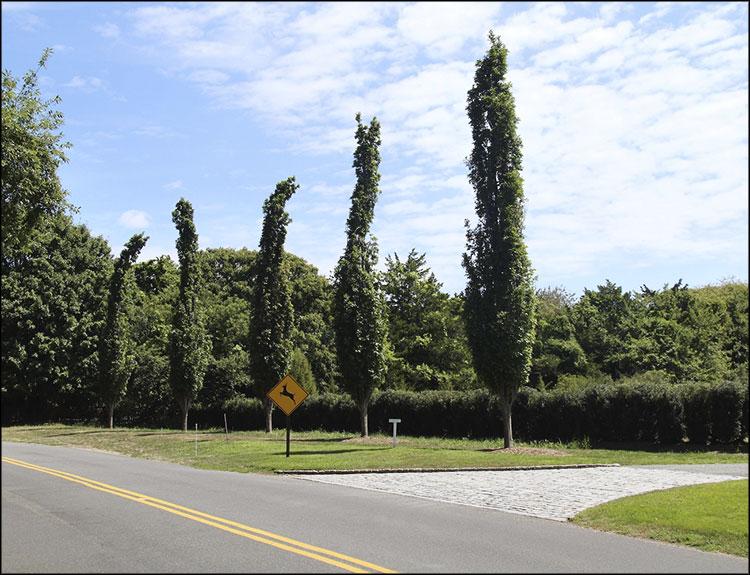Monday night’s monthly meeting of the Amagansett Citizens Advisory Committee began with an appeal for support from a resident of Further Lane, Jonathan Sobel, whose new neighbor at number 370 has planted a double hedge along the lane, blocking a cherished vista which, following directives from two town-appointed boards, had been there for 40 years. No fewer than four easements — scenic, agricultural, conservation, and large-lot — have protected the view.
After the new neighbor ignored a request to talk about it, Mr. Sobel said, “I served a demand letter on the town to respect the open-space preservation law.” That too went unanswered, he said — and now, joined by three other “local taxpayers,” he is suing both the neighbor and the town, which have until the end of this month to respond.
“The town should have sued [the neighbor] in state supreme court right away,” said Rona Klopman, the committee’s chairwoman. “The town should get a restraining order.”
“The town told me it’s a private matter between neighbors,” Mr. Sobel replied.
Interjecting for the first time that evening, Councilman Tom Flight, the town board’s liaison to the committee, told the group that the town intends to file for dismissal of Mr. Sobel’s lawsuit. “The Planning Department and the natural resources committee don’t see the town in violation,” he explained.
“We are ready,” Mr. Sobel answered calmly.
“But why did the [planning and zoning boards] put easements — no hedges, no vegetative screening — along Further Lane if they won’t back them up?” asked the committee’s vice chairwoman, Vicki Littman, going straight to the heart of the matter. Mr. Flight agreed that “easements obviously exist,” and told the committee that “I will ask my colleagues why they’re not being enforced.”
Mr. Sobel was not quite finished. “There are plans for structures!” he exclaimed. “They want multiple fences, fountains, all kinds of things.”
There were murmurs in the crowd at that, and some audible gasps. The homeowner, reading from notes, continued: “Forty years ago, the Z.B.A. said that ‘the front field shall be preserved in its present state, with no manmade materials on the property whatsoever.’ “
“Can the committee help spread the word?” Mr. Sobel implored. “The more plaintiffs we have, the better.” Twelve people have expressed support so far, he said, including several bike riders who pass the site regularly.
The 15 or so committee members present voted as one to send a letter of support to the town board.
Councilman Flight had nothing new to report about several items on the evening’s agenda, among them Cantwell Court, the Cranberry Hole Road bridge, and next year’s proposed town budget. Short-term rentals, however, which he called “a major concern, the commercialization of residential neighborhoods by entities buying up multiple properties,” came in for lively discussion.
Short-term rentals are, he suggested, “quite possibly the biggest industry in the town,” calling it imperative not only that the anonymous buyers be identified but also that every house leased be entered on the rental registry. Also, “What are we getting back from the county in terms of money going out?” he wondered, speaking of taxes.
One committee member, Michael Diesenhaus, suggested that the houses being bought up are not necessarily being rented, but treated instead like stocks, “to buy and hold, for speculation.”
The town is buying software, Mr. Flight noted, to help find answers to these and similar questions. One in particular involves certificates of occupancy.
“It’s been taking too long to get C. of O.s,” he said, thus delaying the timely transfer of properties. Part of the problem is that as the town grows, its building inspectors, who grant these certificates, cannot keep up with demand. “We are actively considering hiring licensed architects or engineers” to perform inspections in their stead, the councilman reported.
Jim MacMillan, a committee member who is a real estate agent, had a suggestion: “Let the buyer get the C. of O.,” rather than, as now, the seller. Mr. MacMillan cited a case in point, an elderly widow selling the house she’s lived in for 50 years, who first “has to spend for a new survey and get a C. of O.” Instead, he said, “let the buyer get title and have six months to get the C. of O.”
What was once called the East Hampton Town Senior Citizens Center, then the Center for Modern Aging, now anyone’s guess, was the evening’s final topic. Mr. Flight was asked among other things whether the town will do legal battle with the two erstwhile architects, who are meanwhile battling with each other.
“I can’t talk too much, because we have existing legal stuff with the architects,” he said diplomatically.
Allison Lupo, who lives on Oak Lane adjacent to the land off Abraham’s Path where the center is proposed, and who expressed concerns at last month’s meeting about trespassers, safety hazards, displaced wildlife and overclearing, had a question for the councilman. “Can the town at least revegetate along the railroad track and Stony Hill Road?” she pleaded. “It’s a terrible eyesore.” Mr. Flight promised to bring that up with the town board.
When Mr. MacMillan asked why the center’s location couldn’t be changed, the answer was firm. “There are very few areas of town-owned land where this project can take place,” Mr. Flight said. “There is no other location with minimum impact on the aquifer.”




